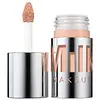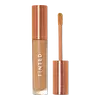What's inside
What's inside
 Key Ingredients
Key Ingredients

 Benefits
Benefits

 Concerns
Concerns

No concerns
 Ingredients Side-by-side
Ingredients Side-by-side

Water
Skin ConditioningCaprylic/Capric Triglyceride
MaskingPolyglyceryl-6 Polyricinoleate
EmulsifyingButylene Glycol
HumectantEthylhexyl Olivate
Skin ConditioningGlycerin
HumectantHeptyl Undecylenate
EmollientPolyglyceryl-2 Isostearate
EmulsifyingDisteardimonium Hectorite
StabilisingPolyglyceryl-10 Pentaisostearate
EmollientMagnesium Sulfate
Aloe Barbadensis Leaf Juice
Skin ConditioningCollagen Amino Acids
MoisturisingCaffeine
Skin ConditioningHedychium Coronarium Root Extract
MaskingEchium Plantagineum Seed Oil
Skin ConditioningHelianthus Annuus Seed Oil Unsaponifiables
EmollientArnica Montana Flower Extract
MaskingOrobanche Rapum Extract
Skin ProtectingCardiospermum Halicacabum Flower/Leaf/Vine Extract
Skin ConditioningTocopherol
AntioxidantHydrogenated Lecithin
EmulsifyingSqualane
EmollientOctyldodecanol
EmollientSilica
AbrasivePropanediol
SolventMica
Cosmetic ColorantEthylhexylglycerin
Skin ConditioningSodium Hyaluronate
HumectantSodium Benzoate
MaskingPotassium Sorbate
PreservativePhenoxyethanol
PreservativeCI 77891
Cosmetic ColorantIron Oxides
Water, Caprylic/Capric Triglyceride, Polyglyceryl-6 Polyricinoleate, Butylene Glycol, Ethylhexyl Olivate, Glycerin, Heptyl Undecylenate, Polyglyceryl-2 Isostearate, Disteardimonium Hectorite, Polyglyceryl-10 Pentaisostearate, Magnesium Sulfate, Aloe Barbadensis Leaf Juice, Collagen Amino Acids, Caffeine, Hedychium Coronarium Root Extract, Echium Plantagineum Seed Oil, Helianthus Annuus Seed Oil Unsaponifiables, Arnica Montana Flower Extract, Orobanche Rapum Extract, Cardiospermum Halicacabum Flower/Leaf/Vine Extract, Tocopherol, Hydrogenated Lecithin, Squalane, Octyldodecanol, Silica, Propanediol, Mica, Ethylhexylglycerin, Sodium Hyaluronate, Sodium Benzoate, Potassium Sorbate, Phenoxyethanol, CI 77891, Iron Oxides
Water
Skin ConditioningShea Butter Ethyl Esters
EmollientPolyglyceryl-6 Pentaoleate
EmulsifyingIsoamyl Laurate
EmollientUndecane
EmollientGlycerin
HumectantDisteardimonium Hectorite
StabilisingCaprylic/Capric Triglyceride
MaskingTridecane
PerfumingJojoba Esters
EmollientMagnesium Sulfate
Niacinamide
SmoothingCaffeine
Skin ConditioningBakuchiol
AntimicrobialSodium Hyaluronate
HumectantSodium Hyaluronate Crosspolymer
HumectantHyaluronic Acid
HumectantHydrolyzed Hyaluronic Acid
HumectantAcacia Decurrens Flower Wax
EmollientAscorbyl Tetraisopalmitate
AntioxidantTocopherol
AntioxidantRaspberry Ketone
MaskingPersea Gratissima Oil
Skin ConditioningHelianthus Annuus Seed Wax
Skin ConditioningPhenoxyethanol
PreservativePropylene Carbonate
SolventGlycolipids
Skin ConditioningEthylhexylglycerin
Skin ConditioningPolyglycerin-3
HumectantPropanediol
SolventHydrolyzed Glycosaminoglycans
HumectantBenzyl Glycol
SolventCitric Acid
BufferingCI 77492
Cosmetic ColorantCI 77491
Cosmetic ColorantCI 77499
Cosmetic ColorantWater, Shea Butter Ethyl Esters, Polyglyceryl-6 Pentaoleate, Isoamyl Laurate, Undecane, Glycerin, Disteardimonium Hectorite, Caprylic/Capric Triglyceride, Tridecane, Jojoba Esters, Magnesium Sulfate, Niacinamide, Caffeine, Bakuchiol, Sodium Hyaluronate, Sodium Hyaluronate Crosspolymer, Hyaluronic Acid, Hydrolyzed Hyaluronic Acid, Acacia Decurrens Flower Wax, Ascorbyl Tetraisopalmitate, Tocopherol, Raspberry Ketone, Persea Gratissima Oil, Helianthus Annuus Seed Wax, Phenoxyethanol, Propylene Carbonate, Glycolipids, Ethylhexylglycerin, Polyglycerin-3, Propanediol, Hydrolyzed Glycosaminoglycans, Benzyl Glycol, Citric Acid, CI 77492, CI 77491, CI 77499
 Reviews
Reviews

Ingredients Explained
These ingredients are found in both products.
Ingredients higher up in an ingredient list are typically present in a larger amount.
Caffeine is most associated with coffee, tea, and cacao. In skincare, it helps with calming inflammation and is rich in antioxidants.
While caffeine is used to treat cellulite and and dark circles, further studies are needed to prove this. It has been believed to help with these skin conditions due to its ability to dilate blood vessels and increase blood flow.
Some studies are looking into caffeine's ability to protect against UV rays.
Learn more about CaffeineThis ingredient is an emollient, solvent, and texture enhancer. It is considered a skin-softener by helping the skin prevent moisture loss.
It helps thicken a product's formula and makes it easier to spread by dissolving clumping compounds.
Caprylic Triglyceride is made by combining glycerin with coconut oil, forming a clear liquid.
While there is an assumption Caprylic Triglyceride can clog pores due to it being derived from coconut oil, there is no research supporting this.
Learn more about Caprylic/Capric TriglycerideDisteardimonium Hectorite comes from the clay mineral named hectorite. It is used to add thickness to a product.
It can also help stabilize a product by helping to disperse other ingredients.
Hectorite is a rare, white clay mineral.
Learn more about Disteardimonium HectoriteEthylhexylglycerin (we can't pronounce this either) is commonly used as a preservative and skin softener. It is derived from glyceryl.
You might see Ethylhexylglycerin often paired with other preservatives such as phenoxyethanol. Ethylhexylglycerin has been found to increase the effectiveness of these other preservatives.
Glycerin is already naturally found in your skin. It helps moisturize and protect your skin.
A study from 2016 found glycerin to be more effective as a humectant than AHAs and hyaluronic acid.
As a humectant, it helps the skin stay hydrated by pulling moisture to your skin. The low molecular weight of glycerin allows it to pull moisture into the deeper layers of your skin.
Hydrated skin improves your skin barrier; Your skin barrier helps protect against irritants and bacteria.
Glycerin has also been found to have antimicrobial and antiviral properties. Due to these properties, glycerin is often used in wound and burn treatments.
In cosmetics, glycerin is usually derived from plants such as soybean or palm. However, it can also be sourced from animals, such as tallow or animal fat.
This ingredient is organic, colorless, odorless, and non-toxic.
Glycerin is the name for this ingredient in American English. British English uses Glycerol/Glycerine.
Learn more about GlycerinMagnesium Sulfate is a salt. More specifically, it is an epsom salt, or the bath salt used to help relieve muscle aches.
Despite having ‘sulfate’ in the name, it isn’t a surfactant or cleansing agent like sodium lauryl sulfate. Unlike those sulfates, magnesium sulfate doesn’t have the same cleansing or foaming properties (it's simply a type of salt).
In cosmetics, Magnesium Sulfate is used to thicken a product or help dilute other solids. It is a non-reactive and non-irritating ingredient.
One study shows magnesium deficiency may lead to inflammation of the skin. Applying magnesium topically may help reduce inflammation.
You can find this ingredient in sea water or mineral deposits.
Learn more about Magnesium SulfatePhenoxyethanol is a preservative that has germicide, antimicrobial, and aromatic properties. Studies show that phenoxyethanol can prevent microbial growth. By itself, it has a scent that is similar to that of a rose.
It's often used in formulations along with Caprylyl Glycol to preserve the shelf life of products.
Propanediol is an all-star ingredient. It softens, hydrates, and smooths the skin.
It’s often used to:
Propanediol is not likely to cause sensitivity and considered safe to use. It is derived from corn or petroleum with a clear color and no scent.
Learn more about PropanediolSodium Hyaluronate is hyaluronic acid's salt form. It is commonly derived from the sodium salt of hyaluronic acid.
Like hyaluronic acid, it is great at holding water and acts as a humectant. This makes it a great skin hydrating ingredient.
Sodium Hyaluronate is naturally occurring in our bodies and is mostly found in eye fluid and joints.
These are some other common types of Hyaluronic Acid:
Learn more about Sodium HyaluronateTocopherol (also known as Vitamin E) is a common antioxidant used to help protect the skin from free-radicals and strengthen the skin barrier. It's also fat soluble - this means our skin is great at absorbing it.
Vitamin E also helps keep your natural skin lipids healthy. Your lipid skin barrier naturally consists of lipids, ceramides, and fatty acids. Vitamin E offers extra protection for your skin’s lipid barrier, keeping your skin healthy and nourished.
Another benefit is a bit of UV protection. Vitamin E helps reduce the damage caused by UVB rays. (It should not replace your sunscreen). Combining it with Vitamin C can decrease sunburned cells and hyperpigmentation after UV exposure.
You might have noticed Vitamin E + C often paired together. This is because it is great at stabilizing Vitamin C. Using the two together helps increase the effectiveness of both ingredients.
There are often claims that Vitamin E can reduce/prevent scarring, but these claims haven't been confirmed by scientific research.
Learn more about TocopherolWater. It's the most common cosmetic ingredient of all. You'll usually see it at the top of ingredient lists, meaning that it makes up the largest part of the product.
So why is it so popular? Water most often acts as a solvent - this means that it helps dissolve other ingredients into the formulation.
You'll also recognize water as that liquid we all need to stay alive. If you see this, drink a glass of water. Stay hydrated!
Learn more about Water